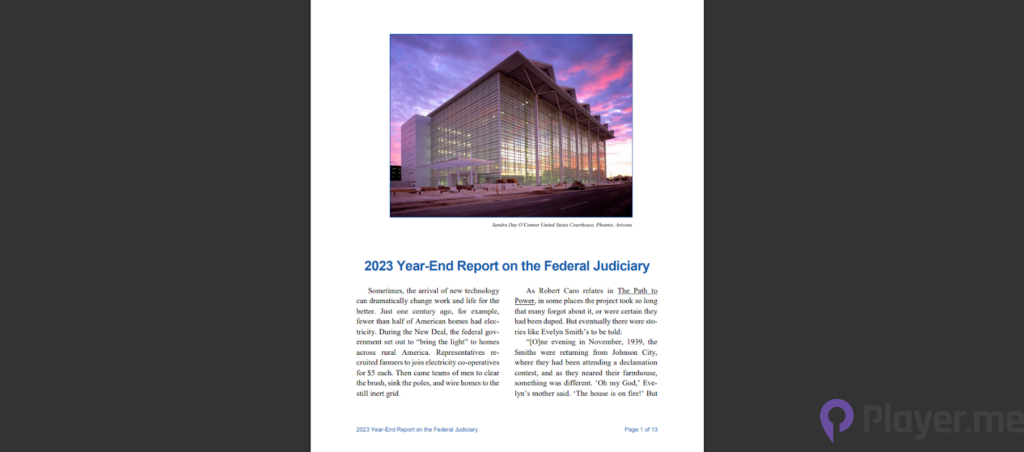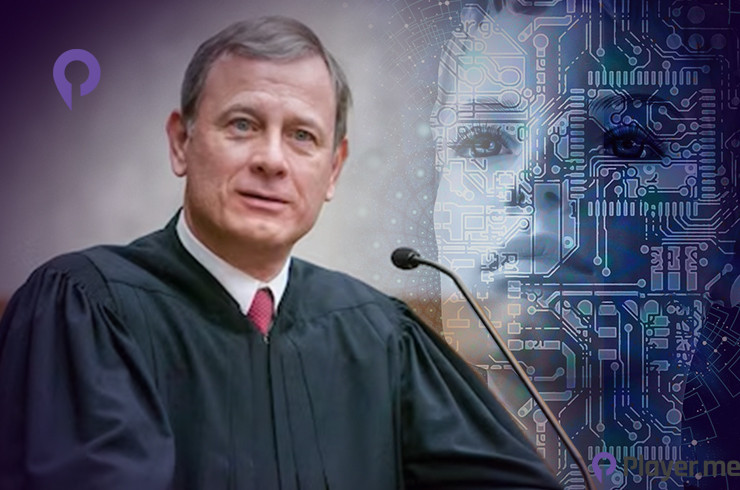In U.S. Chief Justice John G. Roberts Jr.’s annual “Year-end Report on the Federal Judiciary“, the spotlight shines on the technological evolution of the American court system. While historical reflections and acknowledgements of technological advancements take centre stage, the report also features a cautious exploration of Artificial Intelligence (AI) applications in federal courts.
Technological Advancements in the U.S. Court System

From the use of quill pens by justices in the 19th century to the advent of electronic databases in the 1980s and the recent shift to online trial proceedings prompted by the COVID-19 pandemic, the Chief Justice highlights the transformative power of technology. Special recognition is given to the unsung heroes of the judiciary – technologists and cybersecurity experts who ensure the seamless functioning of the judicial branch.
Artificial Intelligence’s Potential and Risks
Amidst the celebration of technological progress, Chief Justice Roberts turns his attention to the “Latest technological frontier” – artificial intelligence. He acknowledges AI’s potential to democratise access to justice, particularly for individuals who cannot afford legal representation. The Chief Justice recognizes that AI could dramatically increase access to key information for both lawyers and non-lawyers alike.
However, a note of caution is sounded. Roberts highlights the risks associated with AI, including its potential to invade privacy interests and dehumanise the legal process. This caution is underscored by a recent incident where AI-generated fake legal citations found their way into official court records, raising concerns about the reliability and integrity of AI in legal research.
Ethics Controversies and the Supreme Court’s Reputation
The Supreme Court’s reputation is under scrutiny due to ongoing ethics controversies, including reports of lavish travel and gifts, leading to historically low public approval ratings. The fallout from the 2022 decision to overturn Roe v. Wade further contributes to the erosion of public trust. Moreover, news reports revealing that some justices accepted luxury travel funded by billionaire friends have intensified the criticism.
In an attempt to address concerns, the Supreme Court adopted a formal code of conduct for the justices in November. The code, aimed at promoting “integrity and impartiality”, marks a significant development. However, critics argue that it grants justices too much discretion over recusal decisions and lacks a robust mechanism for holding them accountable if they violate the established rules.
Also Read: Meta Confirms Intention to Appeal US Judge’s Ruling in Privacy Fight with FTC
Challenges for 2024 and Transparency Demands
The year 2024 brings forth politically consequential legal questions with the potential to reshape the presidential election. Key issues involve Trump’s eligibility for the 2024 ballot, claims of presidential immunity, and critical matters such as gun control, federal agency power, and online free speech. Against this backdrop, calls for increased transparency and accountability echo loudly, urging the Supreme Court to regain public trust.
Chief Justice Roberts acknowledges the importance of 2023 as a pivotal year for judicial ethics. While praising the adoption of the formal code of conduct as a positive step, critics, such as Gabe Roth, Executive Director of Fix the Court, emphasised the need for pronounced improvements in transparency and accountability.
The Supreme Court, facing critical decisions in the coming months, is urged not to merely hope that questions surrounding their conduct fade away but to actively address concerns to preserve public trust.
Chief Justice’s Caution on Artificial Intelligence
In his report, Chief Justice Roberts casts a wary eye on the burgeoning role of artificial intelligence in the federal courts. Describing AI as the “latest technological frontier”, he discusses both the advantages and potential drawbacks of incorporating AI into the legal profession. While recognizing its potential to enhance access to justice, Roberts warns against the risks, emphasising the need for caution and humility when utilising AI in the legal realm.

The Chief Justice cites a recent incident where lawyers using the AI chatbot ChatGPT were fined after citing fake legal cases, illustrating the challenges and pitfalls associated with AI integration. He notes that AI-generated content in legal research should be approached with caution, asserting that “Any use of AI requires caution and humility”.
AI’s Potential to Enhance Access to Justice
Roberts acknowledges the transformative potential of AI in increasing access to justice, particularly for individuals with limited financial resources. AI, he suggests, can provide a means for both lawyers and non-lawyers to access key information more efficiently, levelling the playing field in the legal landscape. The Chief Justice envisions AI as a tool that can bridge the gap between available resources and the urgent needs within the court system.

Despite recognizing AI’s potential, Chief Justice Roberts underscores the irreplaceable role of human judgment in legal determinations. He asserts that while AI can inform legal decisions, it cannot fully replace key actors in the courtroom. Drawing an analogy to the precision of optical technology in tennis tournaments determining whether a ball is in or out, Roberts emphasises that legal determinations often involve grey areas requiring the nuanced application of human judgment.
AI Ethics Is Very Important for the Future of Justice
Chief Justice Roberts’s year-end report provides a comprehensive overview of the U.S. court system’s technological evolution and the cautious exploration of AI applications. As the Supreme Court grapples with ethics controversies, transparency demands, and pivotal cases in 2024, the Chief Justice’s insights into the promises and pitfalls of AI offer a roadmap for navigating the future of justice.
The delicate balance between harnessing AI’s potential to enhance access to justice and mitigating its risks underscores the need for a thoughtful and measured approach to technological integration in the legal profession. Stay informed with Player.me so you don’t miss any important AI news.
Read More: ByteDance Are Copying OpenAI? Account Suspended for Allegedly Covert Use of AI Tech
Author Profile
Latest entries
 GAMING2024.06.12Top 4 Female Tekken 8 Fighters to Obliterate Your Opponents in Style!
GAMING2024.06.12Top 4 Female Tekken 8 Fighters to Obliterate Your Opponents in Style! NEWS2024.03.18Elon Musk’s SpaceX Ventures into National Security to Empower Spy Satellite Network for U.S.
NEWS2024.03.18Elon Musk’s SpaceX Ventures into National Security to Empower Spy Satellite Network for U.S. GAMING2024.03.17PS Plus: 7 New Games for March and Beyond
GAMING2024.03.17PS Plus: 7 New Games for March and Beyond GAMING2024.03.17Last Epoch Necromancer Builds: All You Need To Know About It
GAMING2024.03.17Last Epoch Necromancer Builds: All You Need To Know About It





